Adaptive Profile
This article presents key characteristics of the adaptive profiles like this one on the right, which are assessed by the GRI’s survey, and represents a person’s individual performance in context. The measures are pivotal for a more objective understanding of people, and for applying this understanding at a job and organizational levels as well.
What the Profile Tells
The adaptive profiles inform about a person’s most natural way to perform (Natural, the graph at the bottom), the perception to adapt to the environment (Role, the graph in the middle) and how both graphs translate into the effective way to perform (Effective, the graph on the top), the behaviors that will most probably be observed.
Each graph shows four factors (the four small dots in each graph) and scales (the rectangles above and below the graphs) that indicate how intense and predictable a person is. An adaptive profile represents a person’s way to think, feel, and act. Depending on your experience of other measures and concepts, the measures can also be understood as a representation of a person’s mindset, preferences, and (behavioral) values. A profile has intensity: people express their behaviors more or less visibly and intensely. What is measured is not personality traits or types, although those concepts can be inferred from the adaptive profiles, but rather how people function.
Why Using Profiles
Measures comparable to the GRI are usually represented in various formats, such as reports, histograms, scatter charts, or pies. The different formats are usually combined in reports.
The conciseness of the profiles has proven its advantage for efficiently learning, memorizing, and continuing to use the information on people and jobs whenever needed: What’s expected in the job that can be found in people? What energy does it take to adapt to the job or a situation? The comparisons and answers are immediate.
Each of the four factors adds meaning to the three others. The four factors combine in the profile, bringing many nuances that would be impossible with a different representation.
Our brain interprets symbols by processing them instantly with all the information attached to them, along with other information and their context. As we have studied at GRI, the data conveyed by the profiles rapidly becomes extensive. Their users can enhance with them the quality of their judgment whenever necessary, which, with people, can be constant. The visual condensed representation is the most powerful aspect of the measure. Narrative reports cannot provide the conciseness of profiles. They are typically repetitive: the same information is used similarly for analyzing various traits or types. Important nuances cannot be memorized and used along with other information. They don’t allow easy comparisons; profiles do.
The Same Happened with Other Measures
What happens with the measures provided by the adaptive profiles is no different from other measures of, let’s say, time, temperature, distance, and weight, once their measurement is available with an instrument and can be trusted. Their results can be used in a way that enhances the objectivity of the concepts being measured and allows for their use in ways that were not possible before.
Of critical importance is the quality and practicality of the measure, which are discussed in other articles. Operationalizing performance with the adaptive profiles allows for viewing the various existing performance models from a new perspective and making the most of them.[1].
Relearning Performance
Like with any instrument, trusting their metrics and utility when you use them for the first time requires envisioning their benefits. Having a more objective understanding of how people function, behave, and adapt with the adaptive profiles opens new perspectives at an individual and organizational level. The profiles can help improve individual performance, while also boosting a group's overall performance, improving the communication and decision-making within the group, reducing its chance of underperforming, and benefiting each of its stakeholders in return.

